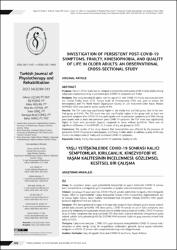| dc.contributor.author | Uçgun, Hikmet | |
| dc.contributor.author | Kodaz, Elif | |
| dc.contributor.author | Arslan, Kübra | |
| dc.contributor.author | Soysal, Nisa Nur | |
| dc.contributor.author | Genç, Selen | |
| dc.contributor.author | Güneş, Sümeyya Betül | |
| dc.contributor.author | Akıncı, Buket | |
| dc.date.accessioned | 2024-04-04T06:00:21Z | |
| dc.date.available | 2024-04-04T06:00:21Z | |
| dc.date.issued | 2023 | en_US |
| dc.identifier.citation | Uçgun, H., Kodaz, E., Arslan, K., Soysal, N. N., Güneş, S. B., & Akıncı, B. (2023). INVESTIGATION OF PERSISTENT POST-COVID-19 SYMPTOMS, FRAILTY, KINESIOPHOBIA, AND QUALITY OF LIFE IN OLDER ADULTS: AN OBSERVATIONAL CROSS-SECTIONAL STUDY (0th ed., pp. 284-293). TURKISH JOURNAL OF PHYSIOTHERAPY REHABILITATION-TURK FIZYOTERAPI VE REHABILITASYON DERGISI. https://doi.org/10.21653/tjpr.1178637 | en_US |
| dc.identifier.issn | 2651-446X | |
| dc.identifier.uri | https://hdl.handle.net/20.500.12900/332 | |
| dc.description.abstract | Purpose: The aim of this study was to compare kinesiophobia and quality of life in older adults among subgroups created according to persistent post-COVID-19 symptoms and frailty.
Methods: This study included 63 adults over the age of 65 with COVID-19.. Frailty was assessed with the Clinical Frailty Scale (CFS). Tampa Scale of Kinesiophobia (TSK) was used to assess the kinesiophobia and The World Health Organization Quality of Life Instrument-Older Adults Module (WHOQOL-OLD) was used to assess quality of life.
Results: The TSK score was significantly higher in the visibly frail and frail group than in the non-frail group (p=0.040). The TSK score was also significantly higher in the group with at least one persistent symptom after COVID-19 than participants with no persistent symptoms (p=0.008). Among participants with at least one persistent post-COVID-19 symptom, the TSK score was significantly higher in those with persistent dyspnea compared to those without (p=0.016). There was no significant difference in the WHOQOL-OLD scores of any sub-groups (p>0.05).
Conclusion: The results of the study showed that kinesiophobia was affected by the presence of persistent COVID-19 symptoms and dyspnea, and frailty in older adults. In addition, quality of life was found to be independent of frailty and persistent COVID-19 symptoms. | en_US |
| dc.language.iso | eng | en_US |
| dc.publisher | TURKEY ASSOC PHYSIOTHERAPISTS | en_US |
| dc.relation.isversionof | 10.21653/tjpr.1178637 | en_US |
| dc.rights | info:eu-repo/semantics/openAccess | en_US |
| dc.subject | Yaşlı | en_US |
| dc.subject | Elderly | en_US |
| dc.subject | Akut sonrası COVID19 Sendromu | en_US |
| dc.subject | Post-acute COVID19 Syndrome | en_US |
| dc.subject | Yaşam kalitesi | en_US |
| dc.subject | Quality of Life | en_US |
| dc.title | INVESTIGATION OF PERSISTENT POST-COVID-19 SYMPTOMS, FRAILTY, KINESIOPHOBIA, AND QUALITY OF LIFE IN OLDER ADULTS: AN OBSERVATIONAL CROSS‑SECTIONAL STUDY | en_US |
| dc.type | article | en_US |
| dc.department | İstanbul Atlas Üniversitesi, Sağlık Bilimleri Fakültesi, Fizyoterapi ve Rehabilitasyon Bölümü | en_US |
| dc.authorid | https://orcid.org/0000-0002-7211-1805 | en_US |
| dc.contributor.institutionauthor | Uçgun, Hikmet | |
| dc.identifier.volume | 34 | en_US |
| dc.identifier.issue | 3 | en_US |
| dc.identifier.startpage | 284 | en_US |
| dc.identifier.endpage | 293 | en_US |
| dc.relation.journal | TURKISH JOURNAL OF PHYSIOTHERAPY REHABILITATION-TURK FIZYOTERAPI VE REHABILITASYON DERGISI | en_US |
| dc.relation.publicationcategory | Makale - Uluslararası Hakemli Dergi - Kurum Öğretim Elemanı | en_US |

















